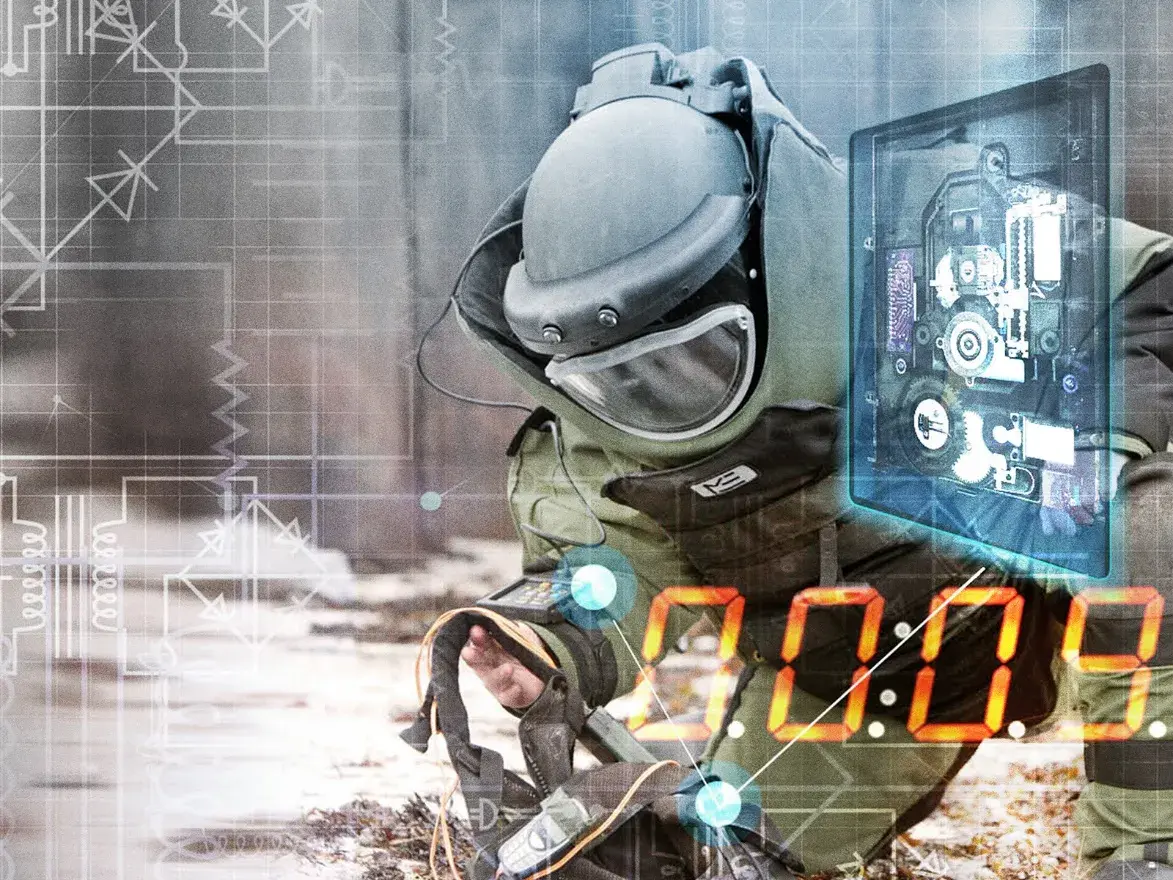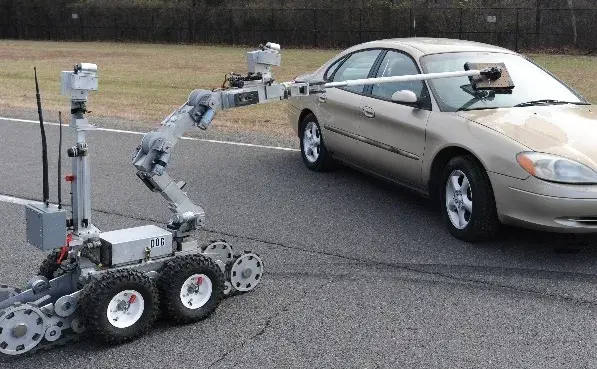To ensure bomb techs are on the cutting edge of technology as they address evolving threats, the Department of Homeland Security (DHS) Science and Technology Directorate (S&T) created the Response and Defeat Operations Support (REDOPS) program. REDOPS connects the 466 bomb squads of varying sizes and budgets across the country with the tools and information they need to perform their duties better, faster and more safely. They look at a variety of sources—including the commercial marketplace, responder communities and international partners—for high- and low-tech solutions.
The reach and impact of REDOPS
 The program’s creation followed the Boston Marathon bombing in 2013 with the goal of providing support to state and local bomb technicians.
The program’s creation followed the Boston Marathon bombing in 2013 with the goal of providing support to state and local bomb technicians.
“That was the genesis of the REDOPS program,” said William Stout, Deputy Director of First Responder Technologies. “Since that time, we have been able to successfully create and establish relationships with the bomb squad community in conjunction with other federal agencies like the Federal Bureau of Investigations (FBI), the Department of Defense and the Department of Energy.”
S&T leverages its relationship with the FBI and other agencies to reach the whole of the bomb squad community across the nation. All bomb technicians receive training and certification from the FBI Hazardous Devices School, which is where the REDOPS program transitions its tools and technologies.
“In essence, this program reaches 100 percent of the community we set out to help,” Stout said.
The REDOPS mission is more than delivering tools and technologies; the program also evaluates existing tools to give technicians the peace of mind that their equipment will work as intended in the event of a bomb threat.
“We want to make sure existing tools work safely and effectively by providing objective feedback to better inform the bomb squad community as a whole,” said Byung Hee Kim, S&T program manager for REDOPS.
To do that, REDOPS evaluates commercially-available technologies such as X-ray systems, robots or remote firing systems through hands-on operational field assessments. After that the program provides feedback to vendors regarding effectiveness, quality and pricing.
“The feedback comes directly from bomb technicians that are using and evaluating the equipment during the testbed assessments. This feedback is then used to improve the tested technology,” said Kim. “So, we are driving vendor innovation to benefit the community.”
Finding the best tech for varying bomb squad sizes and budgets
With critical incidents happening in communities nationwide, having tools for all budgets and all sizes of bomb squads is essential for this diverse responder community.
To address these varying needs, REDOPS finds, develops, and evaluates a range of high- and low-tech solutions from various sources. REDOPS regularly scans the marketplace to find the right tools for bomb technician needs. For example, the REDOPS team has found inspiration from other first responder communities such as firefighters, as their tools can be dual use.
“There are times when bomb squads run into challenges for which there are limited technical solutions, so they develop their own solutions,” said Kim. “These technicians are very smart. At times they use off-the-shelf commercial materials to build the necessary solution — we then test them for safety and share them across the bomb squad community.”
Handmade tools for handmade bombs
“We realized in this program that just because a bomb technician has an expensive piece of technology, it doesn’t mean that they can do their job effectively,” said Kim. “Sometimes handmade tools can do the job equally well, if not better; and they are more cost effective.”
Instead of purchasing expensive technology that may not work in the field, they make it from materials found in their local home improvement stores. Bomb technicians frequently develop tools to meet their evolving needs, save their bomb squad money and when shared, support the broader bomb squad community.
Following are some of the cost-effective tools the REDOPS team has recommended for bomb squads across the nation to incorporate into their toolbox:
 Rubber grip for door handles/knobs (approx. $10). One issue bomb technicians have is that they often cannot access doors or pull doors effectively from a distance or with a robot due to its linear movement. The rubber grip provides the robot with a tight grip that can be used on door handles and car doors.
Rubber grip for door handles/knobs (approx. $10). One issue bomb technicians have is that they often cannot access doors or pull doors effectively from a distance or with a robot due to its linear movement. The rubber grip provides the robot with a tight grip that can be used on door handles and car doors.
 Remote key/Remote door opener (approx. $20). Current robot models cannot turn a key in the door to open it and sometimes even break the key. Bomb technicians use this long-rod key holder to insert and turn a key.
Remote key/Remote door opener (approx. $20). Current robot models cannot turn a key in the door to open it and sometimes even break the key. Bomb technicians use this long-rod key holder to insert and turn a key.
 Fiber optic hinge holder (approx. $5). Bomb-disarming robots are tethered on long fiber optic cables, which are expensive, very fragile and hard to repair. This tool adds a protective layer for the cable to ensure maximum maneuverability for the robot without the risk of damaging the cable.
Fiber optic hinge holder (approx. $5). Bomb-disarming robots are tethered on long fiber optic cables, which are expensive, very fragile and hard to repair. This tool adds a protective layer for the cable to ensure maximum maneuverability for the robot without the risk of damaging the cable.
 Kite reel for lines (approx. $15-$60). One of the challenges that bomb technicians have, even the tactical community, is how to carry lines; and lines can have multiple uses. Kite reel strings with ultimate strength of 200 lbs. are commercially available.
Kite reel for lines (approx. $15-$60). One of the challenges that bomb technicians have, even the tactical community, is how to carry lines; and lines can have multiple uses. Kite reel strings with ultimate strength of 200 lbs. are commercially available.
 Underwater cutting tool (approx. $30-$40). This sharp tool is used on dry land by the safety community to cut a seatbelt under which someone is stuck; it can also cut clothing, Kevlar ropes, cotton ropes, and plastics. But REDOPS recommends it for underwater situations as well. If there is a bomb underwater with a supporting line, this tool can cut it.
Underwater cutting tool (approx. $30-$40). This sharp tool is used on dry land by the safety community to cut a seatbelt under which someone is stuck; it can also cut clothing, Kevlar ropes, cotton ropes, and plastics. But REDOPS recommends it for underwater situations as well. If there is a bomb underwater with a supporting line, this tool can cut it.
“We found this simple tool through our market research on a safety website,” said Kim. “One of the things we do, when we look for things like this, is evaluate every single possibility.”
Finding solutions internationally
The bomb squad community isn’t limited to the United States, which is why the REDOPS program works with international partners to develop technologies that can benefit localities worldwide. A recent example of this is the program’s partnership with the Israeli National Police. Together they are working on a dual-arm robot project. Bomb robots currently in use are single-arm robots.
“So, when looking at how to negotiate a bomb, the bomb squad will have two appendages to work with instead of just one,” said Kim.
To ensure the dual-arm robot meets the needs of both countries, several U.S. bomb squads from New Jersey State Police, Fairfax County Police and Michigan State Police are participating in the various stages of development to provide user feedback for the final product. Multiple prototypes will be available in December 2018 for the bomb squad community to test and to be able to continue to refine the secondary robotic arm.
Join the community!
The bomb squad community is in great need of solutions at various price points and capabilities. REDOPS aims to meet these needs by working with the community and delivering information and tools in an effective and efficient way to combat homeland security threats.
If you are a bomb technician, you may be interested in joining the REDOPS community at S&T’s First Responders Communities of Practice (FRCoP). FRCoP is a network of vetted, active and retired first responders, emergency response professionals and federal, state, local or tribal homeland security officials. This network not only offers information repositories and content creation tools, but also provides networking capabilities for practitioners across the country to connect with one another in a trusted, online environment.
For additional information about REDOPS, please contact .
